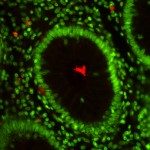Link to Pubmed [PMID] – 14562958
J. Mol. Evol. 2003 Aug;57(2):140-8
In Shigella and enteroinvasive Escherichia coli (EIEC), the etiologic agents of shigellosis in humans, the determinants responsible for entry of bacteria into and dissemination within epithelial cells are encoded by a virulence plasmid. To understand the evolution of the association between the virulence plasmid and the chromosome, we performed a phylogenetic analysis using the sequences of four chromosomal genes (trpA, trpB, pabB, and putP) and three virulence plasmid genes (ipaB, ipaD, and icsA) of a collection of 51 Shigella and EIEC strains. The phylogenetic tree derived from chromosomal genes showed a typical “star” phylogeny, indicating a fast diversification of Shigella and EIEC groups. Phylogenetic groups obtained from the chromosomal and plasmidic genes were similar, suggesting that the virulence plasmid and the chromosome share similar evolutionary histories. The few incongruences between the trees could be attributed to exchanges of fragments of different plasmids and not to the transfer of an entire plasmid. This indicates that the virulence plasmid was not transferred between the different Shigella and EIEC groups. These data support a model of evolution in which the acquisition of the virulence plasmid in an ancestral E. coli strain preceded the diversification by radiation of all Shigella and EIEC groups, which led to highly diversified but highly specialized pathogenic groups.

